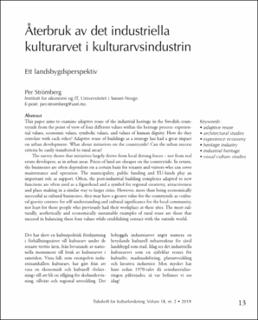| dc.contributor.author | Strömberg, Per | |
| dc.date.accessioned | 2020-03-17T12:29:31Z | |
| dc.date.available | 2020-03-17T12:29:31Z | |
| dc.date.created | 2020-01-13T14:01:54Z | |
| dc.date.issued | 2019 | |
| dc.identifier.citation | Tidsskrift for kulturforskning. 2019, 18 (2), 13-34. | en_US |
| dc.identifier.issn | 1502-7473 | |
| dc.identifier.uri | https://hdl.handle.net/11250/2647187 | |
| dc.description | Innholdet på dette nettstedet er lisensieret under en Creative Commons Navngivelse-DelPåSammeVilkår 4.0 Internasjonal lisens. | en_US |
| dc.description.abstract | This paper aims to examine adaptive reuse of the industrial heritage in the Swedish countryside from the point of view of four different values within the heritage process: experiential values, economic values, symbolic values, and values of human dignity. How do they correlate with each other? Adaptive reuse of buildings as a strategy has had a great impact on urban development. What about initiatives on the countryside? Can the urban success criteria be easily transferred to rural areas? The survey shows that initiatives largely derive from local driving forces – not from real estate developers, as in urban areas. Prices of land are cheaper on the countryside. In return, the businesses are often dependent on a certain basis for tenants and visitors who can cover maintenance and operation. The municipality, public funding and EU-funds play an important role as support. Often, the post-industrial building complexes adapted to new functions are often used as a figurehead and a symbol for regional creativity, attractiveness and place making in a similar way to larger cities. However, more than being economically successful as cultural businesses, they may have a greater value for the countryside as «cultural gravity centres» for self-understanding and cultural significance for the local community, not least for those people who previously had their workplace at these sites. The most culturally, aesthetically and economically sustainable examples of rural reuse are those that succeed in balancing these four values while establishing contact with the outside world. | en_US |
| dc.language.iso | swe | en_US |
| dc.relation.uri | http://ojs.novus.no/index.php/TFK/article/view/1730/1712 | |
| dc.rights | Navngivelse-DelPåSammeVilkår 4.0 Internasjonal | * |
| dc.rights.uri | http://creativecommons.org/licenses/by-sa/4.0/deed.no | * |
| dc.title | Återbruk av det industriella kulturarvet i kulturarvsindustrin. Ett landsbygdsperspektiv. | en_US |
| dc.type | Peer reviewed | en_US |
| dc.type | Journal article | en_US |
| dc.description.version | publishedVersion | en_US |
| dc.source.pagenumber | 13-34 | en_US |
| dc.source.volume | 18 | en_US |
| dc.source.journal | Tidsskrift for kulturforskning | en_US |
| dc.source.issue | 2 | en_US |
| dc.identifier.cristin | 1771538 | |
| cristin.ispublished | true | |
| cristin.fulltext | original | |
| cristin.qualitycode | 1 | |

